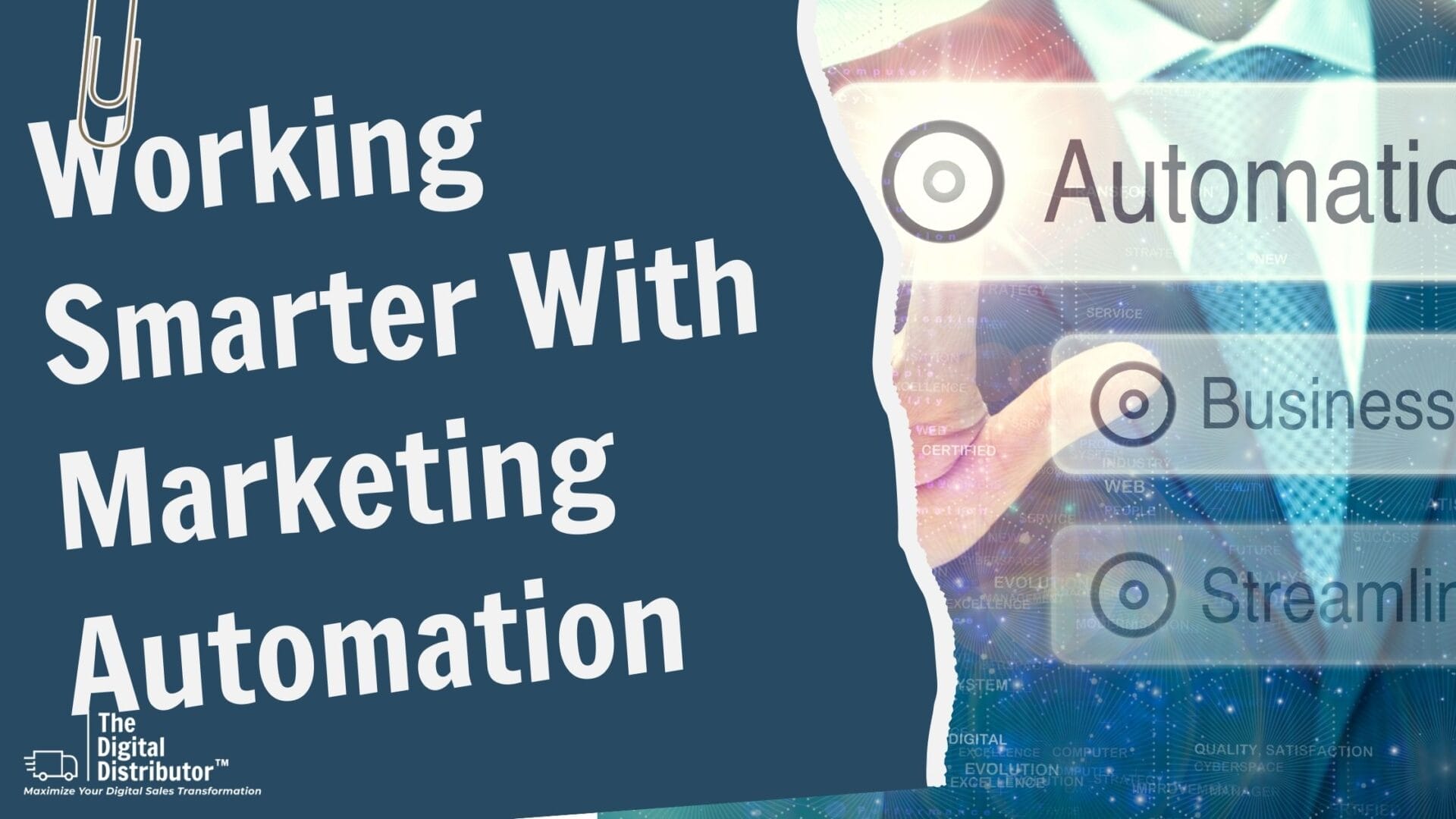Marketing automation is a catch-all phrase for software platforms designed to share digital sales and marketing collateral effectively.
“Work smarter, not harder.”
“Let’s do more with less.”
You are an anomaly if you haven’t heard (or said) these phrases in the workplace. After all, every company seeks opportunities to be more efficient, productive, and lean.
Will working smarter impact your bottom line? Typically, yes. But what if you don’t know how best to work smarter?
And will you be more financially sound by doing more with less? Sure, but how is that possible within your current business model?
Your Business Never Stops Running
 Let’s start with an unspoken truth: there is only so much your team can do. Humans require sleep and vacation time to be productive. And while I’m sure you embrace and encourage that, the reality is that your business can and should continue to run 24 hours a day, seven days a week.
Let’s start with an unspoken truth: there is only so much your team can do. Humans require sleep and vacation time to be productive. And while I’m sure you embrace and encourage that, the reality is that your business can and should continue to run 24 hours a day, seven days a week.
It’s a dichotomy of many businesses: the ongoing struggle of knowing you need to do more with less but not being able to do so because you’re already working with less or unsure what to do to get there.
It would help if you had more hours in the day, but you are stuck with only 24 (and unfortunately, you and your team can’t work all of them).
To accomplish the sales calls and provide the customer experience you know your clients deserve requires a bigger team, but the budget doesn’t agree.
You know your business’s potential, yet you don’t have the capacity or time to explore innovative growth opportunities.
It’s as though you have a finite number of people on your team but infinite things to get done. When it comes to digital sales and marketing, however, there are many ways to do more with less.
For example, in today’s digital world, we see options that help teams be more effective and productive while maintaining a healthy work/life balance, technology that mimics a 24/7 cycle of generating sales leads, and ways to create quality customer experiences around the clock. But how do you choose between all the options available?
Artificial Intelligence in Business
 Artificial Intelligence has been around for quite some time, and almost all of us benefit from it daily. From Google pre-populating our search bars to Netflix recommending movies to us to getting the latest weather report from Alexa, technology has perfected the personalization of our everyday world. This is machine learning in its simplest form.
Artificial Intelligence has been around for quite some time, and almost all of us benefit from it daily. From Google pre-populating our search bars to Netflix recommending movies to us to getting the latest weather report from Alexa, technology has perfected the personalization of our everyday world. This is machine learning in its simplest form.
Artificial Intelligence (AI) is becoming a part of our society’s DNA, so much so that people expect it at every turn. AI can help you write a book, clean your house, place an online shopping order, and even drive a car. If AI can do that now, imagine the possibilities for the future and imagine the possibilities for your business.
For example, did you know that when used for marketing automation, AI can …
Help you simplify your marketing collateral without adding extra steps or jeopardizing quality. Quality can increase, in fact, and so can your customer experience! By simplifying elements of your business, you are making space to innovate and try something new, and you can encourage your team to do the same.
Help you automate communication without losing your personal touch. Of course, not all automation is the same, and when used correctly, you will increase personalization, not decrease it. You’ll also increase response time and discover additional ways to serve your customers.
Help you predict behavior and outcomes. For example, you can learn about a buyer’s typical purchasing behaviors, which helps you create a higher touch and more meaningful sales experience. In addition, you’d know more about what customers want or require. Acting on this information leads to increased customer satisfaction and sales! A win-win!
Innovation and automation can lead to new opportunities. And those new opportunities may be just what your business needs to continue to set itself apart from the competition.
Where do You Start?
 The answer to that question is, in a nutshell …, It depends.
The answer to that question is, in a nutshell …, It depends.
You can begin with simple, essential marketing automation. Some essential marketing automation functions include email, social media posting, and list-building activities. These basic features streamline and simplify some of the most time-consuming and repetitive digital sales and marketing tasks.
The more robust marketing automation platforms also track and collect data across multiple online channels, allowing you to capture and identify leads quickly and then measure the viability of these leads based on demographics and buyer behavior. It also lets you quickly recognize which digital strategies are most effective at moving your prospects closer to purchasing.
Most importantly, the primary goal of a marketing automation system is to support your sales function by identifying audiences, deploying the right content at the right time in the buyer’s journey, and triggering actions or notifications for your salespeople based on buyer behavior.
With that in mind, I recommend you start by understanding what your business needs most and then selecting a system or platform to support those needs.
To help you uncover what that might be, here are a few questions to consider:
 Would you like to capture, follow up, and nurture leads using segmenting information based on the leads’ interests? Or are you okay with your leads being bucketed into one list and having them all receive identical communications regardless of segments?
Would you like to capture, follow up, and nurture leads using segmenting information based on the leads’ interests? Or are you okay with your leads being bucketed into one list and having them all receive identical communications regardless of segments?
Would you like to identify anonymous website traffic? More than 90% of your website visitors leave without making a purchase. Would you like to know who they are?
Would you like to connect with prospects via social media? Getting traction via social media is challenging for distributors, but some tactics will work for you!
Is qualifying and prioritizing the leads in your sales pipeline essential to your sales process right now? Or are each of your leads treated equally?
Is personalization important to your sales and marketing strategy? Would the ability to segment your audiences based on their behaviors and attributes be valuable to you?
Do you wonder where your marketing dollars are going? Analyzing the granular data marketing automation provides will help you measure and guide the sales and marketing teams’ focus.
Is distributing sales and marketing collateral based on a prospect’s behavior and interests something you’d like your company to do? Do you believe it is vital that you get the right information to the right person at the right time in the most appealing format?
When prospects visit your website, would you like to know what they visited, what they looked at, which pages your website visitors spent time on, and how long they stayed on each page? Would that knowledge give your salespeople more insight into each prospect and what the prospect is looking for?
No answer is right or wrong here, as every business has different goals and plans for accomplishing those goals. That said, every company should be using marketing automation in some capacity. Hands down, it’s essential, and when used effectively, it opens doors you didn’t know could even open.
Five Easy Ways to Begin Using Marketing Automation
You don’t have to go all in all at once. Remember, the tortoise beat the hare, and slow and steady will always win the marketing race. The average distributor will not need all the bells and whistles marketing automation offers. However, I recommend five easy-to-implement strategies and features to every distributor who wants to begin or enhance their digital journey.
Always be Measuring. Knowledge is power, and marketing automation systems gather valuable data. Data, of course, can be measured. And if you can measure it, you can improve it. Analytics will paint a clearer picture of your buyers by giving you an understanding of buyer behaviors.
 Be Available When and Where Customers Need You. A compelling but often overlooked capability is to have a live person available to answer questions and respond to customers 24/7. Live Chat is a service you must add to your website. You can manage the chat function internally and have a live operator monitor it.
Be Available When and Where Customers Need You. A compelling but often overlooked capability is to have a live person available to answer questions and respond to customers 24/7. Live Chat is a service you must add to your website. You can manage the chat function internally and have a live operator monitor it.
Chatbots via artificial intelligence have been around for a while, answering questions and providing standard information. But now, we’re seeing a steep elevation of communication capabilities with Live Chat.
As we stated earlier, 90% of your website visitors leave without taking any action. Live Chat changes this statistic dramatically.
Be Consistent in Communicating. Email marketing is the most basic form of marketing automation. It can be as basic as sending out a newsletter to everyone in your database or as sophisticated as an initial first step in a complex workflow that segments a database and nurtures leads from cold to hot before funneling them to a salesperson to convert. Whether you’re just starting or simply sending a monthly newsletter, that’s okay. Just be sure you’re sending it monthly because subscribers will expect to hear from you.
 Prevent Lost Sales. Have you ever visited a website, added items to your cart, been sidetracked by a different priority, and forgot to complete the purchase? You aren’t alone. Businesses can utilize AI and automation to prevent lost sales by using a simple abandoned shopping cart campaign.
Prevent Lost Sales. Have you ever visited a website, added items to your cart, been sidetracked by a different priority, and forgot to complete the purchase? You aren’t alone. Businesses can utilize AI and automation to prevent lost sales by using a simple abandoned shopping cart campaign.
If you have an eCommerce site, you are likely already using a campaign like this. If you are considering eCommerce or don’t have an abandoned shopping cart campaign in your existing program, it would be a very effective strategy to add.
Capture and Engage with Your Leads. Your ability to capture leads is probably the most critical and valuable feature of having a marketing automation system. Capturing leads and following up with them automatically using personalized messaging is incredibly easy and efficient. It takes a load off your salespeople’s plates so that they can focus on leads closer to a sale. Just think how difficult it would be to do so manually!
We’ve all heard (or said) the adage: “Fifty percent of our marketing works—we just don’t know which 50%.” Marketing automation makes that statement obsolete. Using the most straightforward marketing automation systems and embracing AI’s value can bring to your business, you can quickly learn what was successful and then zero in on why it was.
It’s Okay Not to Know What You Don’t Know.
You likely wear many hats in your business, and digital sales and marketing may seem like something you’ll never figure out. And, unfortunately, this is not the type of endeavor you can start and stop and start and stop. It requires careful planning and top-down buy-in. It also requires a dedicated sales and marketing team.
 You have the sales team, and chances are, you might also have the marketing team. You need a good plan, a roadmap, and a strong leader to get the team from point A to point Z. You don’t have to mobilize your troops alone. Help can be just a phone call away.
You have the sales team, and chances are, you might also have the marketing team. You need a good plan, a roadmap, and a strong leader to get the team from point A to point Z. You don’t have to mobilize your troops alone. Help can be just a phone call away.
I understand the distribution industry, having supported it for close to 10 years. And I’ve seen how powerful marketing automation can be as a digital sales and marketing tool filled with strategies to support your sales team. I know the value marketing automation will bring to your salesforce, marketing team, and bottom line, and I want to help you experience that value, too.
Like any journey worth taking, you’ve got to start this one at the very beginning because skipping steps will impact what happens down the line. For this reason, I’ve pulled the six most critical steps required to get started correctly into a book and an online program – complete with coaching, worksheets, and execution support from me – exclusively designed for distributors. And, if you require done-for-you services, our team is ready to make that happen, too.

